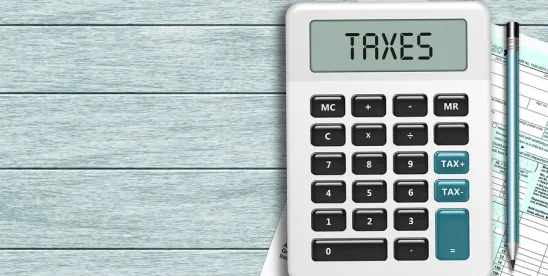Among the more noteworthy changes made by the Tax Cuts and Jobs Act of 2017 was the creation of Code Section 199A [1], which grants a deduction to owners of certain pass-through businesses (i.e., sole proprietorships, partnerships, and S corporations) of up to 20% of qualifying business income (“QBI”) earned by a qualified trade or business. Numerous key aspects of Section 199A were unclear and generated substantial debate about the manner in which the new deduction would be applied. On August 8, 2018, the Department of Treasury issued proposed regulations (REG-107892-18) (the “Proposed Regulations”) that address many of these open questions, though many important issues remain [2]. This alert discusses several key areas and how the Proposed Regulations attempt to address those areas of uncertainty surrounding Section 199A.
Trade or Business Standard
As an initial matter, the Section 199A deduction is available only with respect to activities rising to the level of a “trade or business.” The Code uses several different trade or business standards and it was initially unclear which “trade or business” standard Congress intended to apply for these purposes. The Proposed Regulations provide that each activity must satisfy Section 162’s trade or business standard, which generally requires an activity to be conducted with “continuity and regularity” and with the primary purpose of earning income or making a profit. The adoption of the Section 162 trade or business standard could prove problematic for professionals engaging in rental real estate who will be required to establish that their rental activities meet the Section 162 standard. The Proposed Regulations provide an exception, however, for taxpayers that rent or lease tangible or intangible property to a commonly controlled trade or business. This self-rental activity is treated as a Section 162 trade or business.
Specified Service Trade or Business
One of the hottest areas of debate surrounding Section 199A involves the definition of a “specified service trade or business” (an “SSTB”). To claim the deduction under Section 199A, a trade or business must be a “qualified trade or business,” which includes all trades or businesses except for (i) an SSTB, or (ii) “the trade or business of performing services as an employee.” Under Section 199A, the definition of an SSTB includes (i) any trade or business involving the performance of services in the fields of health, law, accounting, actuarial science, performing arts, consulting, athletics, financial services, brokerage services, or any trade or business where the principal asset of such trade or business is the reputation or skill of one or more of its employees or owners, and (ii) any trade or business that involves the performance of services that consist of investing, investment management, trading, or dealing in securities, partnership interests or commodities.
The Proposed Regulations attempt to provide clarity by building on the relative dearth of case law and administrative guidance interpreting Section 1202. Although it is beyond the scope of this alert to review the details of each service field, we note three significant developments. First, the Proposed Regulations construe the field of “financial services” to exclude banking (i.e., taking deposits or making loans) and exclude from the definition of “brokerage services” those services provided by real estate and insurance agents and brokers. Second, the Proposed Regulations provide that the field of “consulting” does not include consulting services that are embedded in, or ancillary to, the sale of goods if there is no separate payment for the consulting services. This provides both a planning opportunity as well as a potential trap for the unwary for trades or businesses that provide consulting services in addition to the sale or manufacture of goods, such as computer software and programming businesses. Third, the Proposed Regulations narrowly interpret the circumstances in which Section 199A’s inclusion as an SSTB of “any trade or business where the principal asset of such trade or business is the reputation or skill of one or more of its employees or owners” would apply. There had been concern that this category would act as a “catch-all” and ensnare many activities that otherwise would be permissible. The Proposed Regulations, however, limit the application of the “reputation or skill” category to the following: (i) endorsement income for products and services; (ii) income from the licensing of an individual’s image or likeness; and (iii) appearance fees or income. To illustrate this concept, the Proposed Regulations posit a scenario where a well-known chef that owns multiple restaurants also receives an endorsement fee of $500,000 for the use of her name on a line of cookware due to her skills and reputation as a chef. The chef is in the trade or business of being a chef and owning restaurants, which does not constitute an SSTB. However, the chef is also in the business of receiving endorsement income, which does constitute an SSTB.
Prior to the issuance of the Proposed Regulations, it was unclear whether an otherwise qualified trade or business could be “tainted” for purposes of Section 199A by the inclusion of a modestly-sized SSTB. The Proposed Regulations address this concern by creating a de minimis exception under which a trade or business that both sells products and performs otherwise prohibited services can avoid SSTB classification. Specifically, the de minimis exception applies to trades or businesses that have (i) gross receipts of $25 million or less if under 10% of the gross receipts are attributable to an SSTB, or (ii) gross receipts exceeding $25 million if under 5% of the gross receipts are attributable to an SSTB. While the de minimis exception affords some latitude for the inclusion of an SSTB, we note that the satisfaction of the requisite thresholds may be problematic for businesses of substantial size.
Following the enactment of Section 199A, there was significant debate about the ability of a taxpayer to separate an integrated SSTB (such as a law, consulting, or accounting firm) into component businesses that would qualify for the Section 199A deduction and whether the construction of separate entities would be necessary. For example, a law firm could create an employee leasing affiliate and an entity to hold or lease real property. These activities, standing alone, would not constitute an SSTB. The preamble to the Proposed Regulations makes clear that such strategies are inconsistent with the purpose of Section 199A, and the Proposed Regulations attempt to defeat business separations that maintain a high degree of common ownership by including within the definition of an SSTB any trade or business with 50% or more common ownership (directly or indirectly) that provides 80% or more of its property or services to an SSTB. Additionally, if a trade or business has 50% or more common ownership with an SSTB, the portion of the property or services provided to the SSTB will be treated as an SSTB.
The Proposed Regulations also provide that the SSTB determination is best made at the entity level, and thus each pass-through entity is required to determine its SSTB status and disclose that information to its partners, shareholders, and owners.
A Net Loss
When an individual owns multiple qualified trades or businesses, Section 199A directs the individual to calculate the QBI from each separate trade or business and then net the amounts. If a taxpayer’s combined QBI from all qualified trades or businesses results in a negative amount, the taxpayer’s QBI is zero for the current taxable year and the negative amount is carried forward to the subsequent taxable year and treated as negative QBI from a separate qualified trade or business for Section 199A purposes. An area of uncertainty involved a situation where a taxpayer owns a qualified trade or business that produces positive QBI and another qualified trade or business that produces a loss, netting to produce a positive amount. Assuming that the taxpayer does not elect to aggregate (discussed below), when a taxpayer’s net amount of QBI is a positive amount, but at least one of the qualified trades or businesses generates a loss, the Proposed Regulations instruct that such loss must be allocated among the qualified trades or businesses that produce positive QBI in proportion to such positive amounts.
Election to Aggregate
As previously noted, the computation of QBI generally applies to each business on a stand-alone basis before netting the amounts. Section 199A was not clear whether taxpayers would be permitted to aggregate businesses, similar to the grouping regime available for passive activity losses under Section 469. The ability to aggregate businesses is important because it would allow taxpayers to calculate their Section 199A deduction using aggregate QBI, W-2 wages, and unadjusted depreciable property bases. For example, suppose a real estate developer has two partnerships—Partnership 1 has high QBI and a low basis in unadjusted depreciable property, whereas Partnership 2 has a low QBI and a high basis in unadjusted depreciable property. In the absence of aggregation, Partnership 1’s deduction would be limited by its low property basis and Partnership 2 would not have adequate QBI for purposes of the calculation.
The Proposed Regulations would permit (but not require) taxpayers to elect to aggregate separate trades or businesses for purposes of Section 199A. This election is made at the ownership level and generally cannot be revoked once made. In order to make such an election, the taxpayer must first demonstrate that each of the separate trades or businesses to be aggregated meet certain eligibility criteria, including: (i) satisfaction of the trade or business standard; (ii) the same person or group of persons (not required to be the electing taxpayer) owns a majority interest in each business; (iii) no business can be an SSTB; and (iv) establish that the trades or businesses are part of a larger integrated business. The election to aggregate provides a variety of planning opportunities for taxpayers who own multiple businesses and desire to maximize the Section 199A deduction.
Independent Contractors
Although Section 199A prohibits an employee from taking the 20% deduction against his or her wage income, the deduction is available to independent contractors, subject to the limitations discussed above. This advantageous treatment of independent contractors had led many to speculate that Section 199A would lead to a flurry of taxpayers seeking to be reclassified as independent contractors. The Proposed Regulations therefore create a series of rules that are intended to prevent potential abuse. Under the Proposed Regulations, an employee that suddenly becomes an independent contractor while providing substantially the same services, directly or indirectly, to a former employer will be presumed to remain an employee for purposes of Section 199A. This presumption can be overcome if the former employee can show that he or she is performing services in a capacity other than as an employee, as determined under existing Treasury Regulation Sections 31.3121(d)-1, 31.3306(i)-1, and 31.3401(c)-1.
Effective Date
While Section 199A is applicable to taxable years beginning after December 31, 2017 and before January 1, 2026, it was not clear how to treat taxpayers that owned pass-throughs with taxable years beginning before and ending after January 1, 2018. The Proposed Regulations provide that a taxpayer shall treat QBI, W-2 wages, and unadjusted basis of depreciable property as having been received or incurred in the year the pass-through’s taxable year ends. In other words, an individual owning a pass-through with a taxable year beginning before January 1, 2018 will get the benefit of QBI (and W-2 wages and unadjusted depreciable property basis) earned before the effective date.
The Proposed Regulations are scheduled to be published in the Federal Register on August 16, 2018. Comments and requests for public hearing are invited and must be received by a date that is 45 days after August 16, 2018. Taxpayers that wish to submit comments on the Proposed Regulations thus must do so on or before October 1, 2018.
Notes
[1] All Section references are to the Internal Revenue Code of 1986, as amended (the “Code”).
[2] Also on August 8, 2018, the Department of Treasury issued Notice 2018-64, which includes a proposed revenue procedure pertaining to the calculation of W-2 wages for purposes of Section 199A.






 />i
/>i
